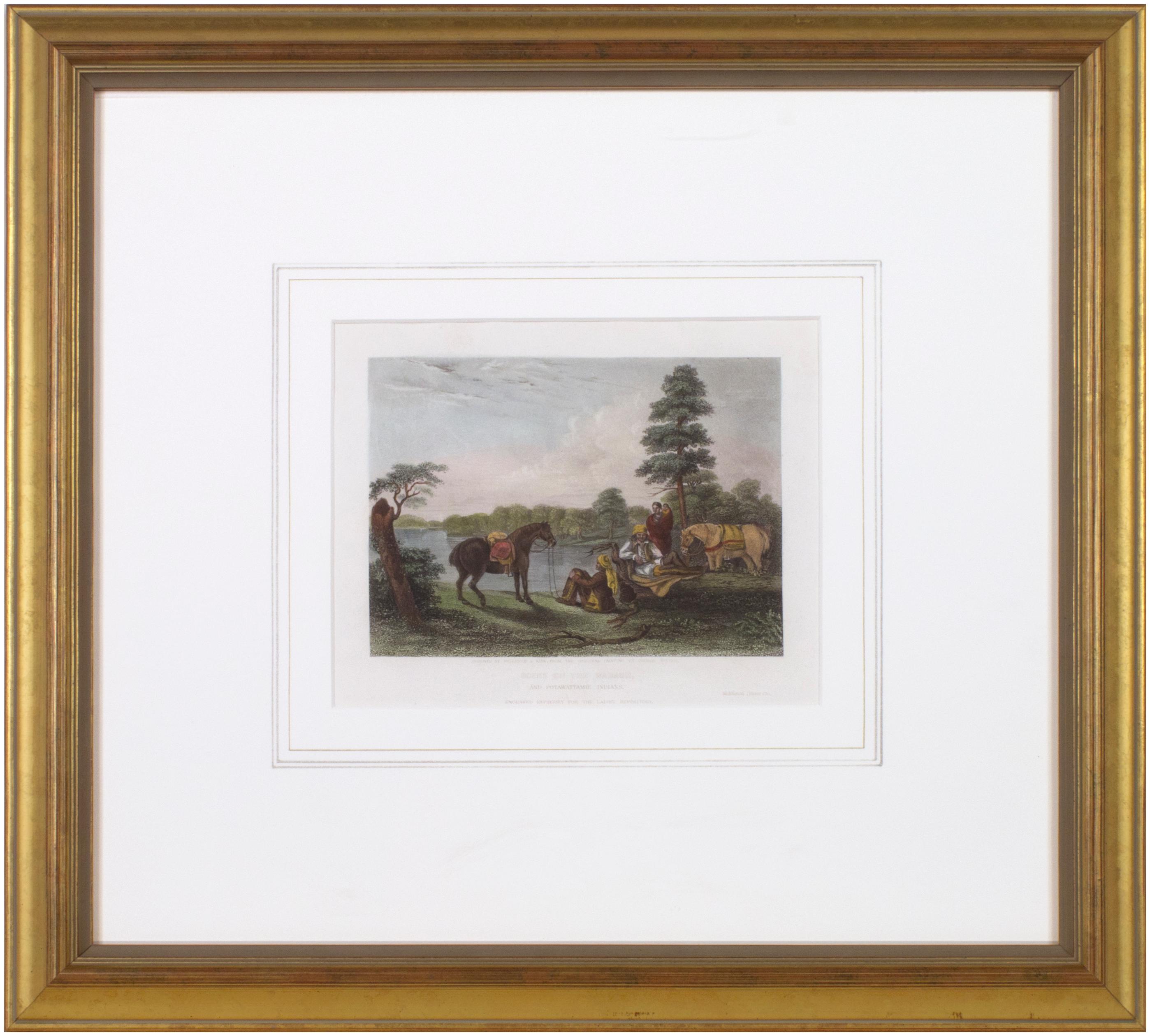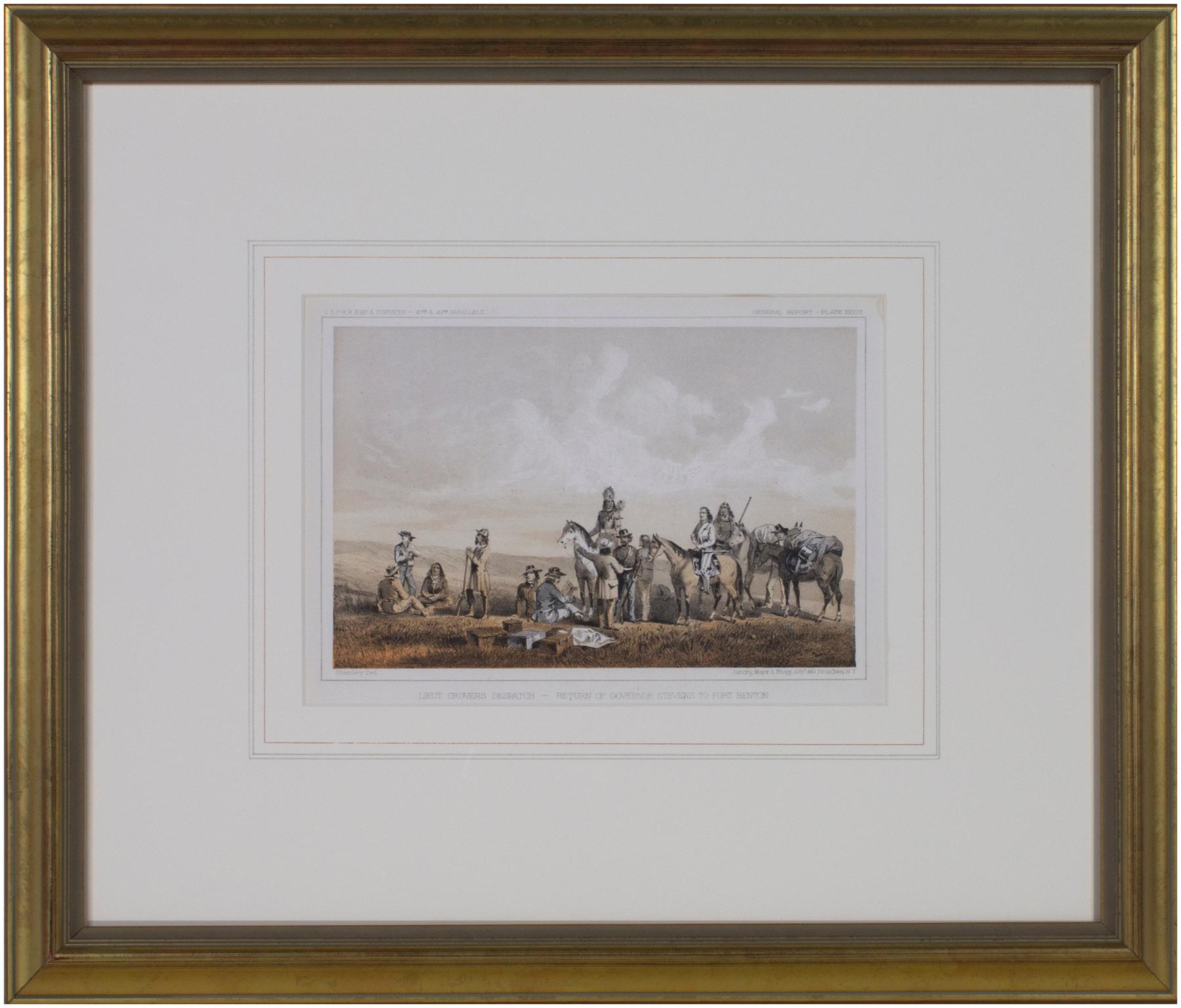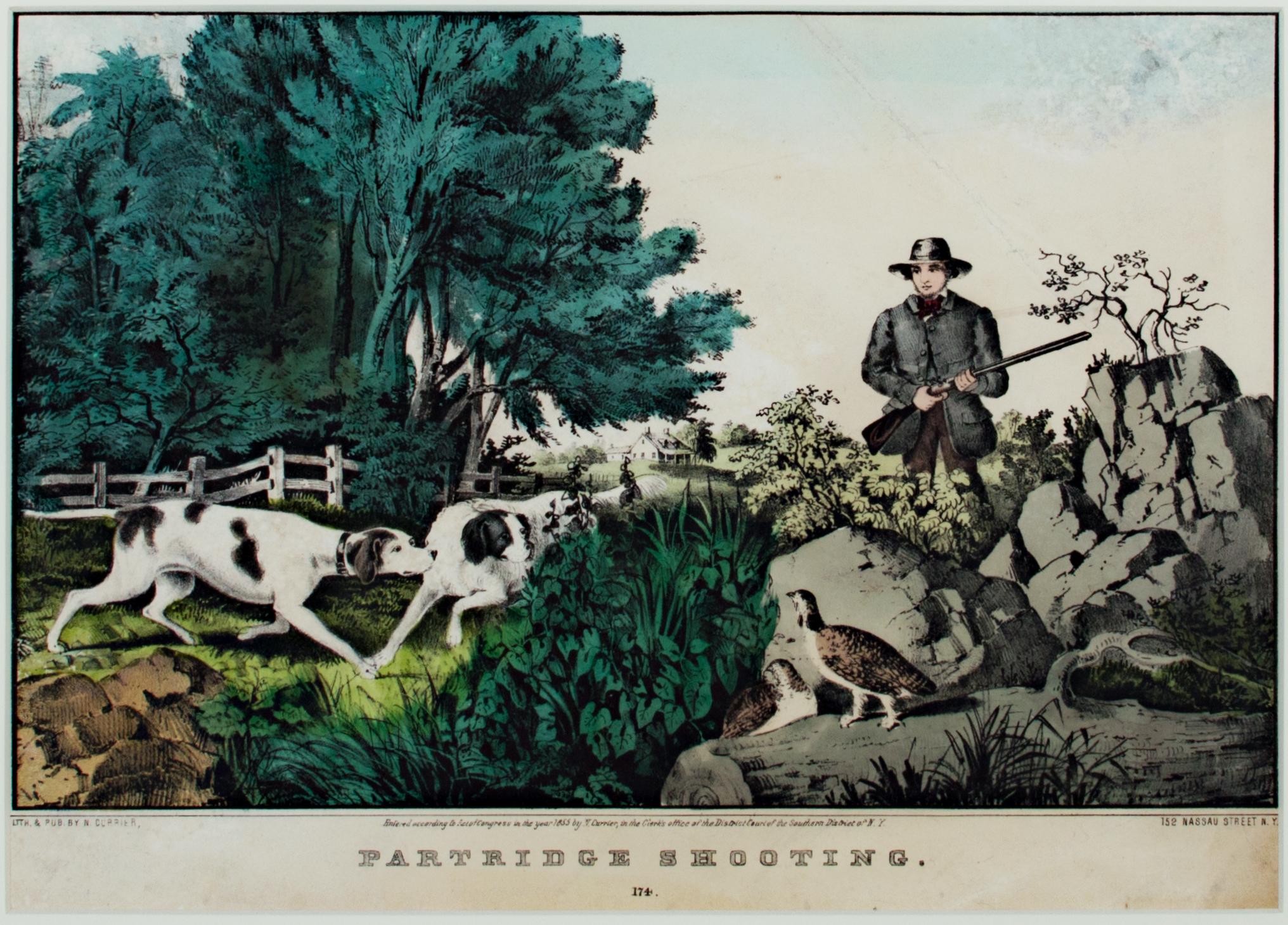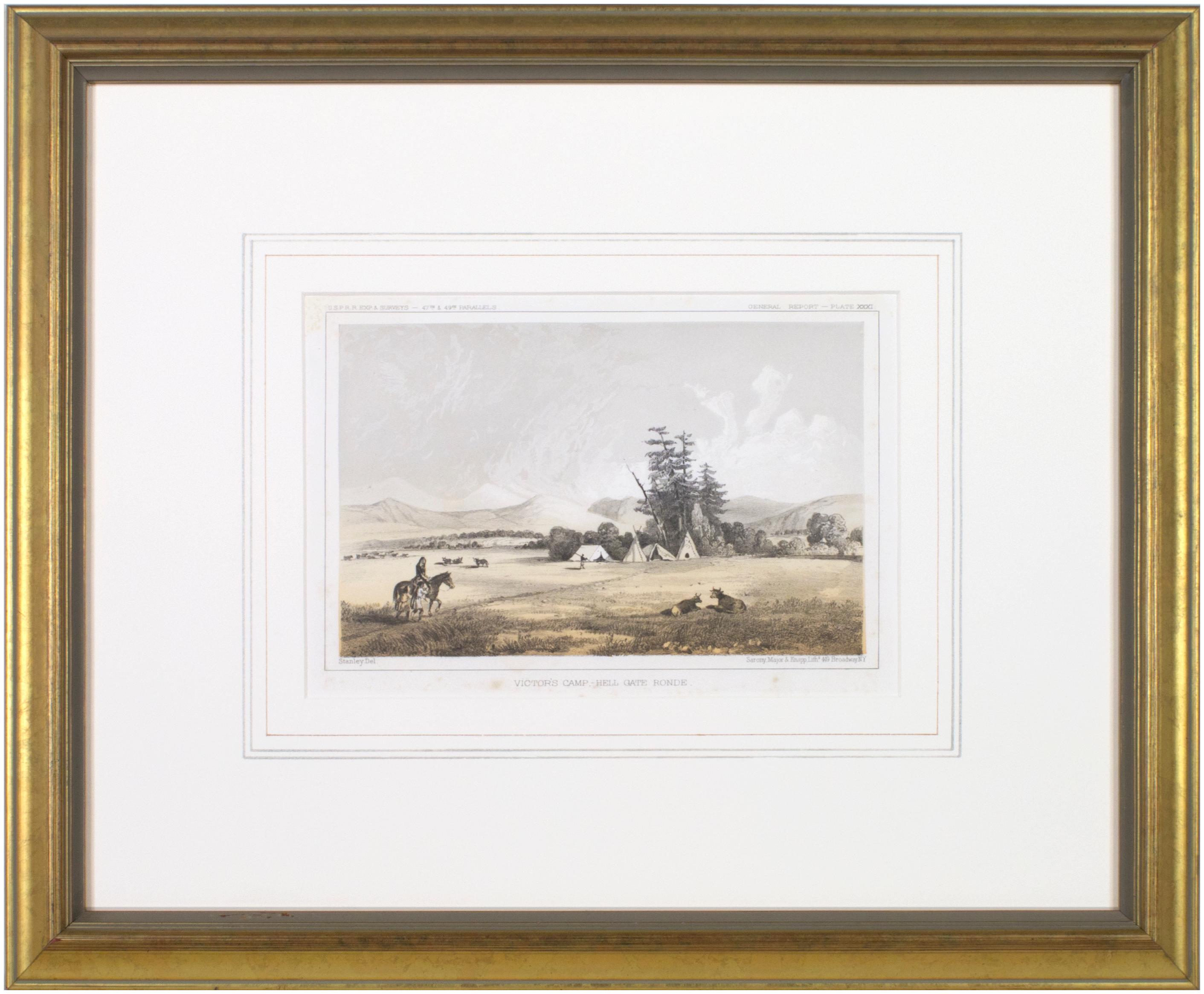Items Similar to "Waterloo Volunteers" From the suite "History of England"
Want more images or videos?
Request additional images or videos from the seller
1 of 11
Graham Clarke"Waterloo Volunteers" From the suite "History of England"1985
1985
About the Item
This artwork titled "Waterloo Volunteers" from the suite "History of England" is an original color etching by British artist Graham Clarke, b.1941. It is hand signed, titled and numbered 69/200 Ed.A in pencil by the artist. The image (plate mark) size is 17 x 13.5 inches, framed size is 24.35 x 21.25 inches. Custom framed in an antique style wood veneer frame with off white matting. It is in excellent condition.
About the artist:
Graham Clarke, artist, author, illustrator and humorist, is one of Britain's most popular and best-selling printmakers. He has created some five hundred images of English rural life and history and of the Englishman's view of Europe. Born in 1941, Clarke's upbringing in the austerity of war-time and post-war Britain, made him reliant on his own imaginative resources. Responding to the comedy of everyday life, he brings his own unique brand of humour to his interpretation of past and present history through the eyes of the common man.
He was educated at Beckenham Art School, where he fell under the spell of Samuel Palmer's romantic and visionary view of the Shoreham countryside. At the Royal College of Art he specialised in illustration and printmaking, and pursued his interest in calligraphy. With encouragement from Edward Bawden, Clarke began refining an individual aesthetic, printing traditional landscapes marked by a sense of locality and genre. Graduating in 1964, he benefited from the print boom of the decade and, with commissions from Editions Alecto and London Transport Publicity Department a promising career was launched. The publication in 1969 of his first hand-printed "livre d'artiste", Balyn and Balan won recognition from the most influential patron and connoisseur of the day, Kenneth Clark. Lord Clark also wrote enthusiastically in praise of Vision of Wat Tyler: "the whole book is a splendid assertion that craftsmen still exist and cannot be killed by materialism. A few idealists are the only hope for decent values".
He has attracted universal admiration for his revival of beautiful, hand-coloured prints in the tradition of Thomas Rowlandson. The famous 'arched top' etchings, with which Graham Clarke established a widely successful reputation in Britain and overseas, came to public attention in 1973 when the first of these, Dance by the Light of the Moon, was exhibited in London at the Royal Academy of Arts Summer Show, and sold out
Examples of his work are held by Royal and public collections, including the Victoria and Albert Museum, the British Museum, the Tate Gallery and the National Library of Scotland in the United Kingdom, as well as by Trinity College, Dublin, the Library of Congress in Washington, D.C., the New York Public Library and the Hiroshima Peace Museum. Many more are to be found on the walls of private homes all over the world, collected systematically by devotees, as well as singly by ordinary art lovers who "know what they like". For over thirty five years Clarke has sustained a remarkable evolutionary development of his work, while remaining true to a philosophy of life and to a democratic ideal which he was already formulating as a schoolboy.
His books, Graham Clarke's "History of England", Graham Clarke's "Grand Tour" and "Joe Carpenter Son, An English Nativity", were published by Phaidon Press. The latter, a verse play, now having been performed more than 300 times in churches and schools worldwide. His 'discovery' of "W. Shakespeare Gent. His Actuale Nottebooke" saw the publication of a quite different work in 1992. This has been followed by "Engelskmann I Lofoten" a Norwegian Sketchbook in 1996. Spring 2000 saw the publication of 'Bait Box Stew', sketches and notes from his beloved Cornwall, and 'KENT', a collection of watercolours on his home territory.
At a ceremony in Canterbury Cathedral in July 1993, an Honorary Degree of Master of Arts was conferred upon Graham Clarke by the University of Kent and in August 1993 Graham was made a Chevalier de la Confrerie du Ceps Ardechois in his favourite part of Southern France. Graham was also named as the Fine Art Trade Guild Artist of the Year 1993. In 1999 he was asked to become an official ambassador for the County of Kent, a role which he pursues with much enthusiasm. For the last twelve years his work has taken him regularly to Japan where he has now become that country's most popular British artist. Kodansha, Japan's largest book publisher, issued "The World of Graham Clarke", an introduction and explanation of eighty Clarke etchings in Japanese, a second edition has now been printed.
Graham Clarke's Millennium window is to be seen in his own parish church of Boughton Monchelsea, Kent. It is unique in that it involves light and sound as well as the stained glass itself. During the year 2000 he produced a large composite wood carving 'The Gloucester Nativity'. Gloucester Cathedral is its home but it is designed to travel and forms the centrepiece at Clarke's retrospective exhibition held at The Royal Museum and Art Gallery, Canterbury in 2001.
Graham Clarke is a man with an overriding sense of tradition, and of religious, social and historical continuities. He takes pride in his view of himself as a local man, a "Man of Kent", with a firm faith in the peace and stability of family, home and community. As such, life and art have always been interdependent, mutually sustaining activities. His wife Wendy, his four children, his animals and friends, the cottage industry he maintains in the village of Boughton Monchelsea where he lives, his comedy band, and the surrounding landscape, offer a microcosm of the world and its history. The scenes he depicts represent both for him and for his everwidening audience, an idyll and a universal ideal.
- Creator:Graham Clarke (1941)
- Creation Year:1985
- Dimensions:Height: 24.35 in (61.85 cm)Width: 21.25 in (53.98 cm)Depth: 1 in (2.54 cm)
- Medium:
- Movement & Style:
- Period:
- Condition:
- Gallery Location:San Francisco, CA
- Reference Number:
About the Seller
5.0
Platinum Seller
These expertly vetted sellers are 1stDibs' most experienced sellers and are rated highest by our customers.
Established in 1999
1stDibs seller since 2017
688 sales on 1stDibs
Typical response time: 1 hour
- ShippingRetrieving quote...Ships From: San Francisco, CA
- Return PolicyA return for this item may be initiated within 7 days of delivery.
More From This SellerView All
- Notre Dame de Paris in WinterBy Liudmila KondakovaLocated in San Francisco, CAThis artwork titled "Notre Dame De Paris in Winter" is an original serigraph by Russian artist Liudmilia Kondakova, born 1956. It is signed and numbered 321/325 in gold felt pen by t...Category
Late 20th Century Romantic Figurative Prints
MaterialsOther Medium
- Apple OrchardBy Pati BannisterLocated in San Francisco, CAThis artwork titled "Apple Orchard" 1998, is a color off set lithograph by British/American artist Pati Bannister, 1929-2013. It is hand signed, titled a...Category
Late 20th Century Romantic Figurative Prints
MaterialsLithograph
- Heiligenblut, AustriaBy Luigi KasimirLocated in San Francisco, CAThis artwork titled "Heiligenblut, Austria" c.1950 is a color etching by Austrian artist Luigi Kasimir 1881-1962. It is hand signed by the artiste's estate in pencil at the lower center. The plate mark (image) size is 7.75 x 5.75 inches, framed is 17.85 x 15.15 inches. It is framed in a wooden antique silver frame. It is in very good condition. About the artist. Luigi Kasimir was born in 1881 at Pettau, today Ptuj, Slovenia, then a part of the Austro-Hungarian monarchy. He inherited his talent from his ancestors; his grandfather was a painter and a poet, and his father an officer in the Habsburg army, who later became a professional painter. Kasimir attended the Vienna Academy of Art where he studied under Wilhelm Unger, who introduced him to the technique of the coloured etching, and also to his future wife, the artist Tanna Hoernes.[1] He died in 1962 in Grinzing, a suburb of Vienna.Kasimir was among the first to develop the technique of the coloured etching. Before this, prints were usually hand-coloured with the colour being applied in a casual, haphazard manner. Kasimir would first create a sketch usually in pastel, he then transferred the design on as many as four to six plates, printing one after the other and applying the colour on the plate, all done by hand. Kasimir is mainly famous for his etchings, but he also produced some oil painting, as well as some pastels. One of his favourite genres was the landscape, or veduta. He demonstrated a predisposition street scenes, and tourist landmarks. He depicted places from all over Europe, mainly Italy, Austria, and Germany. He also travelled to the United States to do a series of etchings of famous sights ranging from urban landmarks such as New York City skyscrapers, to natural wonders like Yosemite Valley. Luigi Kasimir’s etchings...Category
Early 20th Century Realist Figurative Prints
MaterialsEtching
- Klosterneuburg, AustriaBy Luigi KasimirLocated in San Francisco, CAThis artwork titled "Klosterneuburg, Austria" c.1950 is a color etching by Austrian artist Luigi Kasimir 1881-1962. It is hand signed by the artist's estate in pencil at the lower center. The plate mark (image) size is 7.75 x 5.85 inches, framed is 18.15 x 15.15 inches. It is framed in a wooden antique silver frame. It is in very good condition. About the artist. Luigi Kasimir was born in 1881 at Pettau, today Ptuj, Slovenia, then a part of the Austro-Hungarian monarchy. He inherited his talent from his ancestors; his grandfather was a painter and a poet, and his father an officer in the Habsburg army, who later became a professional painter. Kasimir attended the Vienna Academy of Art where he studied under Wilhelm Unger, who introduced him to the technique of the coloured etching, and also to his future wife, the artist Tanna Hoernes.[1] He died in 1962 in Grinzing, a suburb of Vienna.Kasimir was among the first to develop the technique of the coloured etching. Before this, prints were usually hand-coloured with the colour being applied in a casual, haphazard manner. Kasimir would first create a sketch usually in pastel, he then transferred the design on as many as four to six plates, printing one after the other and applying the colour on the plate, all done by hand. Kasimir is mainly famous for his etchings, but he also produced some oil painting, as well as some pastels. One of his favourite genres was the landscape, or veduta. He demonstrated a predisposition street scenes, and tourist landmarks. He depicted places from all over Europe, mainly Italy, Austria, and Germany. He also travelled to the United States to do a series of etchings of famous sights ranging from urban landmarks such as New York City skyscrapers, to natural wonders like Yosemite Valley. Luigi Kasimir’s etchings...Category
Early 20th Century Realist Figurative Prints
MaterialsEtching
- Unter Den Linden Street, Berlin, GermanyBy Luigi KasimirLocated in San Francisco, CAThis artwork titled "Unter Den Linden Street, Berlin, Germany" c.1930 is a color etching on watermarked Kasimir Vienna paper by Austrian artist Luigi Kas...Category
Early 20th Century Realist Figurative Prints
MaterialsEtching
- Golden Gate, San Francisco, CaliforniaBy Luigi KasimirLocated in San Francisco, CAThis artwork titled "Golden Gate, San Francisco, California" c.1930 is a color etching on watermarked Kasimir Vienna paper by Austrian artist Luigi Kasimir, 1881-1962. It is hand sig...Category
Early 20th Century Realist Figurative Prints
MaterialsEtching
You May Also Like
- 'Scene on the Wabush' original engraving by Wellstood & Kirk PottawatomiLocated in Milwaukee, WI"Scene on the Wabash, and Potawattamie Indians" is an original hand-colored engraving, executed by Wellstood & Kirk after the original painting by George Winter. The image captures the kind of scene of the American landscape for which Winter is best known: among the lush trees and flowing rivers, Pottawatomi men, women and children relax from their travels, their horses tied...Category
1860s Romantic Landscape Prints
MaterialsPaper, Engraving, Pigment, Watercolor
- 'Lieutenant Crovers Despatch – Return of Governor Stevens to Fort Benton'By John Mix StanleyLocated in Milwaukee, WIIn the mid-nineteenth century, the United States government set out to survey and document its newly acquired lands and territories west of the Mississippi. The goals of these surveys were manifold: to produce topographical maps, to document flora and fauna, and to document natural resources to build the emerging US economy. These surveys, and the images from them, also functioned to build the new sense of American identity with the landscape, condensing vistas into the 'picturesque' tradition of European image making. Thus, the entire span of US territory could be seen as a single, cohesive whole. This lithograph comes from one of six surveys commissioned by the Army's Topographic Bureau in 1853, which sought to find the best route to construct a transcontinental railroad. The result was a thirteen-volume report including maps, lithographs, and technical data entitled 'Explorations and Surveys to ascertain the most practicable and economical route for a Railroad from the Mississippi river to the Pacific Ocean.' In particular, the print comes from the northern survey, commanded by Isaac Stevens, which explored the regions between the 47th and 49th parallels. 5.75 x 8.75 inches, image 6.5 x 9.25 inches, stone 17 x 20 inches, frame Artist 'Stanley Del.' lower left Entitled 'Lieutenant Crovers Despatch – Return of Governor Stevens to Fort Benton' lower center margin Publisher 'Sarony, Major & Knapp. Lith.s 449 Broadway N.Y.' lower right Inscribed 'U.S.P.R.R. EXP. & SURVEYS — 47th & 49th PARALLELS' upper left Inscribed 'GENERAL REPORT — PLATE XXXVII' upper right Framed to conservation standards using 100 percent rag matting with French accents; glazed with UV5 Plexiglas to inhibit fading; housed in a gold reverse ogee moulding. Print in overall good condition; some localized foxing and discoloration; minor surface abrasions to frame. John Mix Stanley...Category
1850s Romantic Landscape Prints
MaterialsLithograph
- 'Partridge Shooting' original hand-colored lithograph by Nathaniel CurrierBy Nathaniel CurrierLocated in Milwaukee, WIThe present hand-colored lithograph presents the viewer with a hunting scene in a picturesque landscape. In the foreground, a man approaches two partridges as his two pointers prepare to flush them out. Beyond, a white fence draws our eyes to the homestead in the distance. Images like this one show how people in the United States were trying to identify themselves as a new nation in the North American landscape - as separate from their European counterparts but with similar similar and specific wildlife and magesties of nature. It also identifies hunting in this landscape as an American pastime. 9.25 x 12.5 inches, artwork 18.38 x 22 inches, frame Entitled bottom center "Partridge Shooting...Category
Mid-19th Century Romantic Figurative Prints
MaterialsLithograph, Watercolor
- 'Victor's Camp - Hell Gate Ronde' original John Mix Stanley lithographBy John Mix StanleyLocated in Milwaukee, WIIn the mid-nineteenth century, the United States government set out to survey and document its newly acquired lands and territories west of the Mississippi. The goals of these surveys were manifold: to produce topographical maps, to document flora and fauna, and to document natural resources to build the emerging US economy. These surveys, and the images from them, also functioned to build the new sense of American identity with the landscape, condensing vistas into the 'picturesque' tradition of European image making. Thus, the entire span of US territory could be seen as a single, cohesive whole. This lithograph comes from one of six surveys commissioned by the Army's Topographic Bureau in 1853, which sought to find the best route to construct a transcontinental railroad. The result was a thirteen-volume report including maps, lithographs, and technical data entitled 'Explorations and Surveys to ascertain the most practicable and economical route for a Railroad from the Mississippi river to the Pacific Ocean.' In particular, the print comes from the northern survey, commanded by Isaac Stevens, which explored the regions between the 47th and 49th parallels. Stanley shows here the stop the Stanley Party made at the junction of the Bitterroot and Hell Gate, in present day Montana. While there, the Party met with the Flathead Chief by the name Victor, as is shown in the image. The figures and their encampment are dwarfed by the vast landscape around them, indicating the sublimity of these new American territories. 5.75 x 8.75 inches, image 6.5 x 9.25 inches, stone 17 x 20 inches, frame Artist 'Stanley Del.' lower left Entitled 'Victor's Camp - Hell Gate Ronde' lower center margin Publisher 'Sarony, Major & Knapp. Lith.s 449 Broadway N.Y.' lower right Inscribed 'U.S.P.R.R. EXP. & SURVEYS — 47th & 49th PARALLELS' upper left Inscribed 'GENERAL REPORT — PLATE XXXI' upper right Framed to conservation standards using 100 percent rag matting with French accents; glazed with UV5 Plexiglas to inhibit fading; housed in a gold reverse ogee moulding. Print in overall good condition; some localized foxing and discoloration; minor surface abrasions to frame. John Mix Stanley...Category
1850s Romantic Landscape Prints
MaterialsLithograph
- Rue de la Paix, Paris - Hand Colored Lithograph 1845-1860Located in Soquel, CARue de la Paix, Paris - Hand Colored Lithograph 1845-1860 Delicate hand-colored lithograph of Rue de la Paix Palace in Paris, France printed by Rose-Joseph Lemercier (French, 1803 - 1887). Published, Paris 1843 to 1867 by Hautecoeur Freres (Eugène and Alfred Hautecoeur (French). After Charles Riviere...Category
Mid-19th Century Romantic Landscape Prints
MaterialsInk, Watercolor, Paper
- Cottage and HarvestersBy Sir Frank ShortLocated in Storrs, CTCottage and Harvesters (after a watercolor by Peter De Wint, 1784-1849). 1907. Mezzotint. Hardie 88. 6 5/8 x 10 11/16 (sheet 14 x 19 1/4). Edition 100. Housed in a 16 x 20 mat. A ver...Category
Early 1900s Romantic Landscape Prints
MaterialsMezzotint
Recently Viewed
View AllMore Ways To Browse
History Book
Vintage History Book
Scotland And England
Church Of England
The Vintage Boom
Grand Tour Print
Norwegian Art Glass
Four Stained Glass Window
The Nativity
Norwegian Box
Arched Windows Wood
Large Arched Window
The Englishman
Washington National Cathedral
Grand Tour Watercolour
Canterbury Vintage
Twelve Under Plates
Ed Clark




